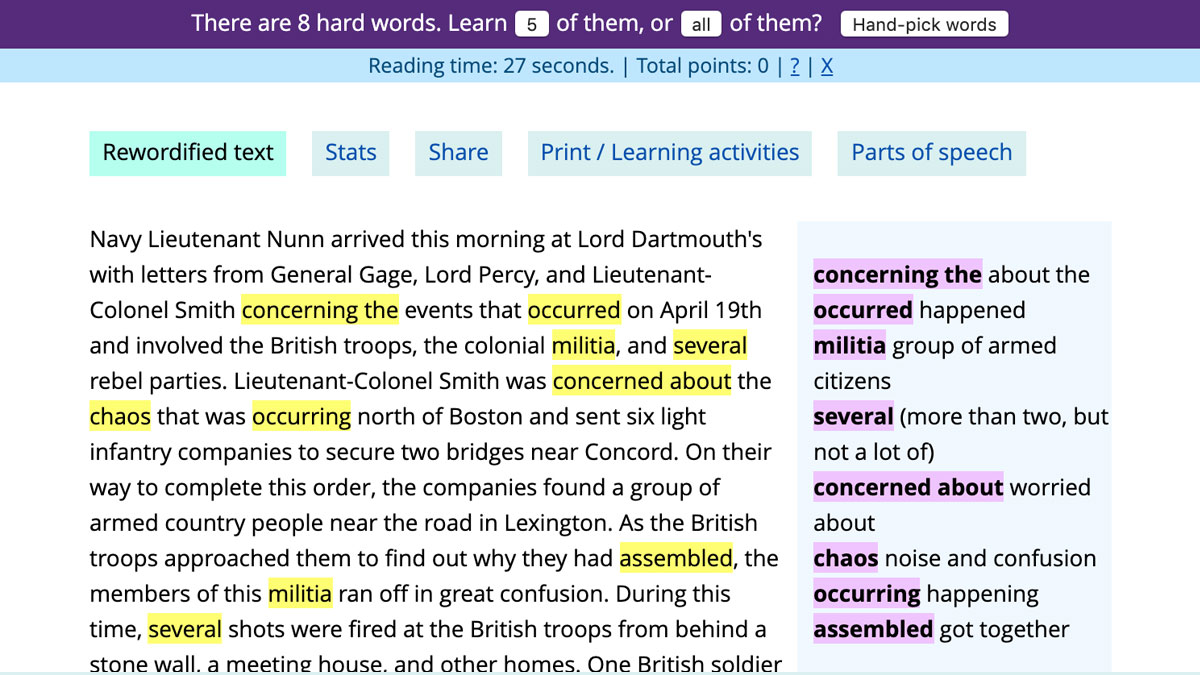Automated Text Simplification
Automated text simplification (ATS) uses automated processes like natural language processing or machine learning to change how texts are worded so that they are easier to understand. Varying the complexity of a text can benefit readers of different ages, levels of engagement, or those who approach text with differing goals. Having automated recommendations for types of simplifications, with options to choose alternate levels of text complexity, means reducing barriers while empowering learners to make choices that work best for them.

Automated text simplification tools, such as Rewordify, may help scaffold challenging texts and build reading comprehension and fluency.
Research
Research suggests people who struggle with reading, including those with reading disabilities, intellectual disabilities, and visual impairments, process human-simplified texts more effectively than non-simplified texts, suggesting that ATS has great potential.
- Saggion, 2017
- Djamasbi et al., 2016
- Djamasbi, Shojaeizadeh, Chen, & Rochford, 2016
- Shojaeizadeh, Djamasbi, Chen, & Rochford, 2017
Most automatic text simplification tools use lexical simplification and syntactic simplification. Lexical simplification is modifying vocabulary to make a text easier to understand. Syntactic simplification is transforming long sentences into simpler sentences. Syntactic simplification is more difficult to automate than lexical simplification; it requires a large amount of human input to train a system to implement this.
Current commercial and open source ATS programs are still in their infancy. Most are unable to function entirely as AI, and often have a behind-the-scenes human element. Additionally, it can be difficult to determine whether ATS successfully improves a text’s readability, since neither ATS tools nor automated tools for measuring readability can fully account for a text’s meaning, or for the relationships among the words. ATS products like Snap & Read, Rewordify, and Kindle Word Wise attempt to simplify texts while preserving their original meanings by providing word definitions alongside simplified word replacements. No research has been conducted to determine whether these types of product features improve or detract from readability and text comprehension. More research is needed to determine how good automated text simplification needs to be for it to be considered useful.
Related Guidelines
The features of the CISL tools are related to existing guidelines and best practices, including the Web Content Accessibility Guidelines (WCAG) and the Universal Design for Learning (UDL) Guidelines. The feature of automated text simplification is connected to:
Web Content Accessibility Guidelines (WCAG)
Cognitive Accessibility Requirements
WCAG includes requirements that address cognitive accessibility. The requirements appear in a subset of guidelines. The guidelines that are most aligned with ATS are listed below:
- Understanding Guideline 3.1 Readable: Make text content readable and understandable.
- Success Criterion 3.1.5 Reading Level (Level AAA): When text requires reading ability more advanced than the lower secondary education level after removal of proper names and titles, you need to ensure that supplemental content, or a version that does not require reading ability more advanced than the lower secondary education level, is available.
Universal Design for Learning (UDL) Guidelines
-
UDL Checkpoint 8.2: Vary demands and resources to optimize challenge
-
UDL Checkpoint 5.3: Build fluencies with graduated levels of support for practice and performance
-
UDL Checkpoint 7.3: Minimize threats and distractions
Examples of ATS in other work:
Want to see examples of the various types of commercial and open-source text simplification and readability evaluation tools currently on the market? Click on the name of the tool below to view its product page.
Text Simplification:
- Snap & Read
- Rewordify
- Kindle Word Wise
- IBM Content Clarifier (also summarizes)
Summarization:
Readability & Complexity Statistics Only
Features in some popular products for text simplification, summarization, and readability statistics:
- Free, standalone webpage:
- Rewordify.com
- Text Compactor
- Free, Open Source:
- texstat
- Users can change the difficulty level of output text:
- Rewordify.com
- Snap&Read
- Users can change the presentation style of the output text:
- Rewordify.com
